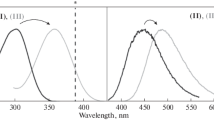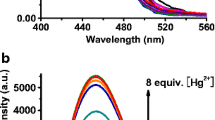Abstract
This report discloses a series of naphthalimide-based bifunctional fluorescent probes for hydrogen peroxide and diols. As a result, these molecules not only demonstrated high turn-on fluorescent response and good selectivity towards hydrogen peroxide over other relevant reactive oxygen species, but also displayed different responses to diols. Therefore, these fluorescent probes could be served as sensitive, selective and practical chemosensors for both hydrogen peroxide and diols under physiological-like conditions.
Similar content being viewed by others
References
Rhee SG. H2O2, a necessary evil for cell signaling. Science, 2006, 312: 1882–1883
Veal EA, Day AM, Morgan BA. Hydrogen peroxide sensing and signaling. Molecular Cell, 2007, 26: 1–14
Bae YS, Kang SW, Seo MS, Baines IC, Tekle E, Chock PB, Rhee SG. Epidermal growth factor (EGF)-induced generation of hydrogen peroxide. Role in EGF receptor-mediated tyrosine phosphorylation. J Biol Chem, 1997, 272: 217–221
Azar ZM, Mehdi MZ, Srivastava AK. Activation of insulin-like growth factor type-1 receptor is required for H2O2-induced PKB phosphorylation in vascular smooth muscle cells. Can J Physiol Pharmacol, 2006, 84: 777–786
Ohba M, Shibanuma M, Kuroki T, Nose K. Production of hydrogen peroxide by transforming growth factor-beta 1 and its involvement in induction of egr-1 in mouse osteoblastic cells. J Cell Biol, 1994, 126: 1079–1088
Strassheim D, Asehnoune K, Park JS, Kim JY, He QB, Richter D, Mitra S, Arcaroli J, Kuhn K, Abraham E. Modulation of bone marrow-derived neutrophil signaling by H2O2: Disparate effects on kinases, NF-kappa B, and cytokine expression. Am J Physiol Cell Physiol, 2004, 286: C683–C692
Geiszt M, Leto TL. The Nox family of NAD(P)H oxidases: Host defense and beyond. J Biol Chem, 2004, 279: 51715–51718
Park HS, Lee SH, Park D, Lee JS, Ryu SH, Lee WJ, Rhee SG, Bae YS. Sequential activation of phosphatidylinositol 3-kinase, beta Pix, Rac1, and Nox1 in growth factor-induced production of H2O2. Mol Cell Biol, 2004, 24: 4384–4394
Sundaresan M, Yu ZX, Ferrans VJ, Irani K, Finkel T. Requirement for generation of H2O2 for platelet-derived growth factor signal transduction. Science, 1995, 270: 296–299
Rhee SG, Bae YS, Lee SR, Kwon J. Hydrogen peroxide: A key messenger that modulates protein phosphorylation through cysteine oxidation. Sci STKE, 2000, 2000: 1–6
Sun W, Wu J, Li J, Fang H, Du L, Li M. Boronate can be the fluorogenic switch for the detection of hydrogen peroxide. Curr Med Chem, 2012, 19: 3622–3634
Kalyanaraman B, Darley-Usmar V, Davies KJ, Dennery PA, Forman HJ, Grisham MB, Mann GE, Moore K, Roberts LJ, 2nd, Ischiropoulos H. Measuring reactive oxygen and nitrogen species with fluorescent probes: Challenges and limitations. Free Radic Biol Med, 2012, 52: 1–6
Lippert AR, Van de Bittner GC, Chang CJ. Boronate oxidation as a bioorthogonal reaction approach for studying the chemistry of hydrogen peroxide in living systems. Acc Chem Res, 2011, 44: 793–804
Rhee SG, Chang TS, Jeong W, Kang D. Methods for detection and measurement of hydrogen peroxide inside and outside of cells. Mol Cells, 2010, 29: 539–549
Du LP, Ni NT, Li MY, Wang BH. A fluorescent hydrogen peroxide probe based on a ‘click’ modified coumarin fluorophore. Tetrahedron Lett, 2010, 51: 1152–1154
Du LP, Li MY, Zheng SL, Wang BH. Rational design of a fluorescent hydrogen peroxide probe based on the umbelliferone fluorophore. Tetrahedron Lett, 2008, 49: 3045–3048
Kuivila HG, Armour AG. Electrophilic displacement reactions. IX. Effects of substituents on rates of reactions between hydrogen peroxide and benzeneboronic Acid1–3. J Am Chem Soc, 1957, 79: 5659–5662
Kuivila HG, Wiles RA. Electrophilic displacement reactions. VII. Catalysis by chelating agents in the reaction between hydrogen peroxide and benzeneboronic acid1,2,3. J Am Chem Soc, 1955, 77: 4830–4834
Zielonka J, Sikora A, Hardy M, Joseph J, Dranka BP, Kalyanaraman B. Boronate probes as diagnostic tools for real time monitoring of peroxynitrite and hydroperoxides. Chem Res Toxicol, 2012, 25: 1793–1799
Wu Z, Li M, Fang H, Wang B. A new boronic acid based fluorescent reporter for catechol. Bioorg Med Chem Lett, 2012, 22: 7179–7182
Gunnlaugsson T, Kruger PE, Jensen P, Tierney J, Ali HD, Hussey GM. Colorimetric “naked eye” sensing of anions in aqueous solution. J Org Chem, 2005, 70: 10875–10878
Sun W, Li W, Li J, Zhang J, Du L, Li M. Naphthalimide-based fluorescent off/on probes for the detection of thiols. Tetrahedron, 2012, 68: 5363–5367
Shen QJ, Jin WJ. Chemical and photophysical mechanism of fluorescence enhancement of 3-quinolineboronic acid upon change of pH and binding with carbohydrates. Luminescence, 2010, 26: 494–499
Jin S, Wang J, Li M, Wang B. Synthesis, evaluation, and computational studies of naphthalimide-based long-wavelength fluorescent boronic Acid reporters. Chemistry, 2008, 14: 2795–2804
Springsteen G, Wang BH. A detailed examination of boronic acid-diol complexation. Tetrahedron, 2002, 58: 5291–5300
Author information
Authors and Affiliations
Corresponding authors
Electronic supplementary material
Rights and permissions
About this article
Cite this article
Sun, W., Ma, Z., Li, J. et al. Bifunctional fluorescent probes for hydrogen peroxide and diols based on a 1,8-naphthalimide fluorophore. Sci. China Chem. 56, 1440–1445 (2013). https://doi.org/10.1007/s11426-013-4870-4
Received:
Accepted:
Published:
Issue Date:
DOI: https://doi.org/10.1007/s11426-013-4870-4




